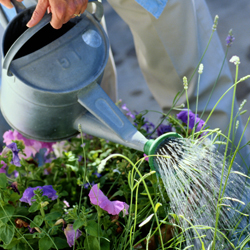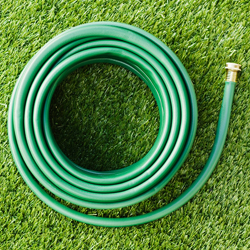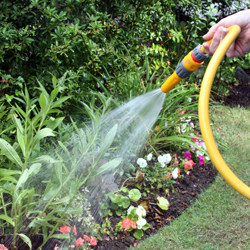

 Water is critical for a healthy garden and landscape, but how much water is too much, how much isn’t enough and how much is just right? Unfortunately, there isn’t a specific answer that suits every gardener’s needs. All plants have different water requirements, which change depending on the type of soil, amount of sun, temperature, humidity, season, maturity of the plant and overall growing environment.
Water is critical for a healthy garden and landscape, but how much water is too much, how much isn’t enough and how much is just right? Unfortunately, there isn’t a specific answer that suits every gardener’s needs. All plants have different water requirements, which change depending on the type of soil, amount of sun, temperature, humidity, season, maturity of the plant and overall growing environment.
Initial Watering
All plants, including specimens described as drought tolerant, will require water when first planted. This is because many of the smaller roots responsible for water uptake are usually damaged during shipment and planting. Build a small circular soil wall around the plant to contain water while it percolates into the soil. Watch new plants carefully and keep them well-watered as their roots settle in and they adapt to their new or transplanted location.
Groups Are Good
It’s a good idea to have some knowledge of the plant’s water requirements when determining the location in the garden. It will keep watering simple if you plant a new specimen near other plants with similar water requirements. In this way, there is no need to readjust an irrigation system or watering schedule, since all the plants in the group have similar needs.
Need a Drink?
Because plants’ watering needs can change through the season, how can you tell if a plant needs more water? Most plants will wilt as the soil becomes too dry. The leaves may droop, and if it’s an upright plant, the top ends may become soft and bend over. Glossy plants may begin to look dull, while thick leaves will shrivel. If you notice these signs, it is time to water! Most plants will revive if watered quickly enough, but be sure to water deeply rather than allowing moisture to run off the surface.
How can you tell if you should water? Push your finger into the soil an inch or two from the base of a plant. Perfect soil should feel cool and slightly moist. Some soil should stick to your finger. If none does, it’s too dry. If it’s muddy, don’t water. Overwatering kills plants by depriving the roots of oxygen. Some gardeners use water meters to see the precise amount of moisture. If you’re unsure, this tool can be helpful.
Adjusting Your Watering Schedule
The amount you have to water your plants or landscape can change from day to day. A cool morning will allow more dew to form and drain to the soil, or a sudden afternoon thunderstorm can be enough water to keep your plants hydrated for a few days. An overly hot day, however, can rapidly deplete water resources and extra watering may be required. Check your plants and landscape regularly to be sure they are getting adequate water, and make adjustments as needed to keep them suitably moist without either too much or too little water.
How MUCH water?
Established lawns require approximately 1 inch of water per week in the summer. Put several
containers out on your lawn and put a mark at a depth of 1 inch. Then turn on the irrigation. Determine
how long it takes to fill the container to the 1 inch mark. Divide the time by 4 and set the zones to run that
amount of time every other day starting at 5:30 am. Keep an eye on the lawn as some zones may need
more or less water due to the soil’s ability to drain.
New lawns – follow the instructions by the installer, or the place of purchase.
Trees or shrubs (3 or 7 gal) installed within the past six months – Each plant will need about 1 inch
of water a day when daytime temperatures are 90 degrees or higher. (Even more if temperatures exceed
100 degrees.) You can use the same container method explained above to determine how long it takes
your irrigation system to put out 1 inch of water. You will need to water for that amount of time every day.
Trees (15 gal) installed within the past six months – Take a 5 gallon bucket and put a hole on the side
near the bottom using a 1/16 inch drill bit (approximately the diameter of the lead in a #2 pencil). Fill it
with water daily, and it will slowly trickle out. Put a brick in the bucket so it doesn’t blow away when it is
empty. For larger trees, use more buckets.
Remember to reduce the water when our high temperatures decrease as we go into the Fall.
If the temperature high is in the:
80’s – water every other day
70’s – water every 3rd day
60’s – water every 4th day
50’s – water once a week
These are some general rules, but not an absolute answer to irrigation of a lawns, trees, and shrubs due
to natural rainfall, soil variables, slopes, drainage, and other issues. Every location is different. Watch
how your plants respond and adjust accordingly.
For more information, https://hgic.clemson.edu/factsheet/watering-shrubs-and-trees/.

